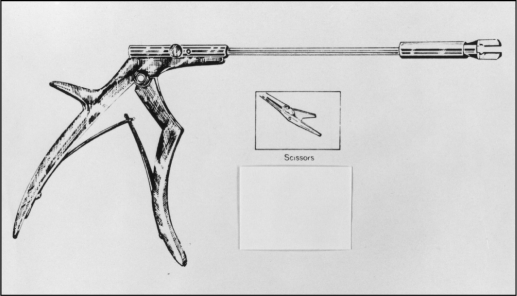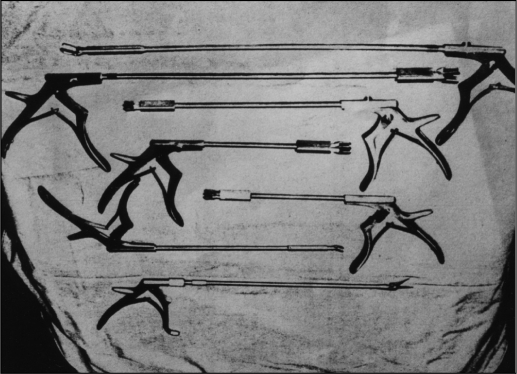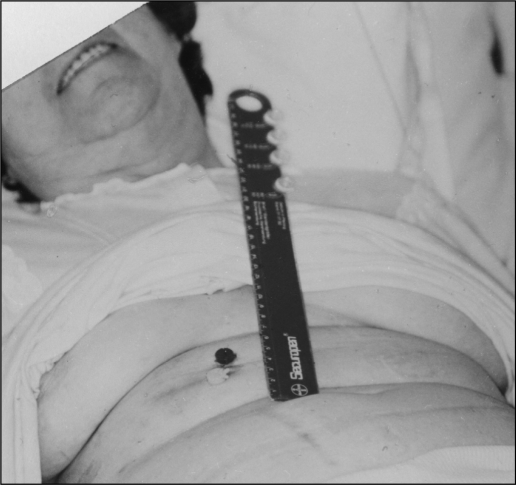Abstract
Prof Dr Med Erich Mühe of Böblingen, Germany, performed the first laparoscopic cholecystectomy on September 12, 1985. The German Surgical Society rejected Mühe in 1986 after he reported that he had performed the first laparoscopic cholecystectomy, yet in 1992 he received their highest award, the German Surgical Society Anniversary Award.
In 1990 in Atlanta, at the Society of American Gastrointestinal Surgeons (SAGES) Convention, Perissat, Berci, Cuschieri, Dubois, and Mouret were recognized by SAGES for performing early laparoscopic cholecystectomies, but Mühe was not. However, in 1999 he was recognized by SAGES for having performed the first laparoscopic cholecystectomy–sAGES invited Mühe to present the Storz Lecture. In Mühe's presentation, titled “The First Laparoscopic Cholecystectomy,” which he gave in March 1999 in San Antonio, Texas, he described the first procedure. Finally, Mühe had received the worldwide acclaim that he deserved for his pioneering work.
One purpose of this article is to trace the development of the basic instruments used in laparoscopic cholecystectomy. The other purpose is to give Mühe the recognition he deserves for being the developer of the laparoscopic cholecystectomy procedure.
Keywords: Laparoscopic cholecystectomy, Laparoscope-galloscope, Hemoclip pistol grip appliers, Scissors
INTRODUCTION
In 1882, Carl Langebuch (1846-1901) of Germany performed the first cholecystectomy.1 In 1985 (103 years later), Prof Dr Erich Mühe of Germany performed the first laparoscopic cholecystectomy (LC).1 He performed 94 such procedures before another surgeon, Phillipe Mouret of Lyon, France, performed his first laparoscopic cholecystectomy in 1987, followed by Francois Dubois of Paris, France, in 1988.1, 2 In several instances, the literature1, 2 gives the French credit for developing the laparoscopic cholecystectomy procedure. The purpose of this article is to recognize Mühe as the true progenitor of laparoscopic cholecystectomy and to trace the development of the instruments used in this procedure.
BASIC INSTRUMENTS USED IN LAPAROSCOPIC CHOLECYSTECTOMY
The 3 most important, basic instruments used in the first laparoscopic cholecystectomy were the laparoscope, the hemoclip, and the pistol grip scissors. The laparoscope had been used by gynecologists for many years for diagnostic purposes before the general surgeon Mühe initiated laparoscopic cholecystectomy in 1985. The other essential instruments used at that time were the hemoclip®, namely the Weck-Reynolds pistol grip clip applier and the Weck-Reynolds pistol grip scissors, which were important for the ligation and cutting of the cystic duct and artery during laparoscopic cholecystectomy. Walker Reynolds, Jr's interest in hemoclips began in 1970 when these devices were used for hemostasis of blood vessels in conjunction with staple surgery.3
In 1971, the first pistol grip applier made by Edward Weck & Co., of Triangle Park, North Carolina, was used by a gynecologist named Gutierrez. He used it for tubal ligations.
In 1972, a pistol grip hemoclip applier was designed by Edward Weck & Co. for Reynolds who developed techniques using hemoclips to ligate ducts and blood vessels for open cholecystectomy and hemorrhoidal veins in hemorrhoidectomy (Figure 1). A pistol grip applier was used rather than a ring applier because visualization was better when applying hemoclips to blood vessels and ducts and provided firmer fixation. Edward Weck & Co. made other pistol grip appliers for Reynolds in different lengths and designs for other surgical procedures 4 (Figure 2).
Figure 1.
Basic pistol grip hemoclip applier and scissors made for W. Reynolds, Jr, MD, in 1972.
Figure 2.
Multiple pistol grip instruments designed by W. Reynolds, Jr, MD.
In 1972, Reynolds also began to use long pistol grip appliers and scissors to remove rectosigmoid polyps through a sigmoidoscope. After ligation of the polyp with hemoclips applied with a pistol grip applier, a cut was made between the hemoclips with the pistol grip scissors, and the polyp was removed. Reynolds' rectosigmoid polypectomy, developed in 1972, utilized these instruments for an open procedure that antedated their use in laparoscopic cholecystectomy. In rectosigmoid polypectomy, pistol grip appliers, scissors, and hemoclips are passed through tubes into the rectosigmoid colon for polypectomy. These maneuvers anticipated the essential techniques for laparoscopic cholecystectomy.4
Reynolds began to perform minimally invasive open cholecystectomies using a pistol grip hemoclip applier and scissors to ligate and cut between the cystic duct and artery.4 This procedure was accomplished by using a vertical, right upper rectus, muscle-sparing incision, retracting the rectus muscle medially. This type of cholecystectomy seemed to lessen postoperative pain as muscle fibers were not severed and allowed a quick recovery with a short postoperative hospitalization.
THE SEARCH FOR PROFESSOR DR MED ERICH MÜHE OF GERMANY
In January 1998, Reynolds began a search for Prof Dr Med Erich Mühe to determine if he used the Weck-Reynolds hemoclip® applier and scissors in his first laparoscopic cholecystectomy. Reynolds was aware that in 1975 Edward Weck & Co. decided to market the hemoclip products in Germany and chose Medimex of Hamburg, Germany, as a distributor. In 1975, Medimex sent Michael Barrett, a surgical technician, to study hemoclip procedures with Peter Samuels, inventor of the hemoclip, and Walker Reynolds, Jr. Michael Barrett was a member of Christiaan Barnard's first heart transplant team in Cape Town, South Africa in 1967. Barrett spent 3 days with Reynolds, who demonstrated hemoclip surgery. A patient operated on at that time went home the same day without an analgesic injection.4,5 Barrett took this knowledge back to Medimex in Germany who marketed Weck products, including the hemoclips with appliers and scissors, to German surgeons.
In January 1998, 23 years later, Reynolds telephoned Medimex in Germany to see whether it was still a viable company. It was very much so. Their general product manager, Gerhard Zumbruch, was most helpful in a telephone conversation of January 16, 1998.6 Later the same day in a fax, he reported that he had managed to talk to Prof Mühe and that Mühe confirmed that he did use the Weck-Reynolds pistol grip applier and scissors in performing the first laparoscopic cholecystectomy in 1985. Later, in a letter to Reynolds from Mühe on January 18, 1998, he confirmed that he used the hemoclip pistol grip appliers and scissors in performing his 94 laparoscopic cholecystectomies. He sent actual pictures of the pistol grip appliers and scissors that he had used.
THE STORY OF ERICH MÜHE
In 1972, Erich Mühe (Figure 3) was an assistant in the Surgical Clinic of the University of Erlangen, headed by Prof Gerd Hegemann. During a 1974 symposium, Mühe had the opportunity to see Frangenheim's film on laparoscopy and was deeply impressed. Upon his return to Erlangen, Mühe immediately told Chairperson Hegemann about the merits of abdominal endoscopy and the superior visualization possible. Hegemann agreed to introduce laparoscopy into the surgical clinic. In 1977, a German group led by Hegemann used the Reynold's technique in 236 patients to perform rectosigmoid polypectomies using the pistol grip appliers and scissors, which was reported in 1977 in Medizin.7 Mühe was a member of this group.
Figure 3.
Prof Dr Med Erich Mühe, World Champion Cyclist for Physicians and Pharmacists in 1987.
Mühe left Erlangen in 1982 and became head of surgery at the Böblingen County Hospital in Bîblingen, Germany. On September 12, 1980, Semm reported a laparoscopic appendectomy performed with a suture technique.8 Mühe became fascinated with Semm's technique and conceived the idea of laparoscopic cholecystectomy. A senior physician in gynecology, Willi-Rinehard Braumann, taught Mühe laparoscopy. Mühe became interested in performing laparoscopic cholecystectomy. He knew that he could ligate the cystic duct and arteries with hemoclips using pistol grip appliers and scissors, having performed rectosigmoid polypectomies with these instruments since 1977.
In 1984, four packages of gynecological endoscopic instruments were delivered to the Böblingen County Hospital. Mühe designed a new operative laparoscope called the “galloscope” (Figure 4). On September 12, 1985, five years to the day from Semm's fully endoscopic appendectomy (1980), Mühe used his laparoscope, the galloscope, for the first LC. He used the pistol grip applier with hemoclips to ligate and pistol grip scissors to cut between the clipped cystic duct and artery. He did not use sutures as Semm had done in his laparoscopic appendectomy.
Figure 4.
Galloscope-Laparoscope invented by Erich Mühe and used in the first laparoscopic cholecystectomy.
MÜHE'S LAPAROSCOPIC CHOLECYSTECTOMY TECHNIQUE
Mühe's description of LC as recorded in Endoscopy9 is as follows: “The first endoscope constructed and used by ourselves (‘Galloscope’) had side-viewing optics, and an instrumentation channel with valves, a light conductor and a duct for the establishment of continuous pneumoperitoneum by the Veress needle technique; the endoscope was introduced through the umbilicus into the peritoneal cavity. For the insertion, we used a sharp mandrin within a trocar sleeve. After removal of the mandrin, a trap valve was ejected from the inner wall of the tube to seal off escaping CO2. When the gallbladder was removed under optical control through the endoscope, the top of the endoscope had to be taken off. However, the gallbladder could also be removed through the trocar sleeve. When this access route from the umbilicus or suprapubic abdominal wall to the gallbladder was used, a pneumoperitoneum was indispensable (Figure 5). Therefore, after the first six operations, we changed the method, and the remaining 88 patients were operated on using a simplified approach, namely laparoscopic cholecystectomy without pneumoperitoneum and without optical guidance. Using an access channel at the costal margin this served as a firm bone roof above the gallbladder, and neither a pneumoperitoneum nor optical guidance was necessary. Only one skin incision of 2.5 cm in length was required compared to at least 3 cm total length needed for three to four incisions when using a pneumoperitoneum”7 (Figure 6).
Figure 5.
Picture of the abdomen of the first patient to have laparoscopic cholecystectomy, September 12, 1985, showing portholes in the lower abdomen.
Figure 6.
Mühe's open tube laparoscopic cholecystectomy, Technique No. 2. Patient with 1 access, directly above the gall-bladder without pneumoperitoneum because the costal arch is a firm bone roof.
In 1986, Mühe presented his findings on laparoscopic cholecystectomy before the German Surgical Society Congress. The audience was skeptical of Mühe's claims. He next presented the lecture on cholecystectomy without laparotomy to the Lower Rhine-Westphalian Society in October 1986 in Cologne. Again, the response to Mühe's lecture was disappointingly weak. Also, the German Surgical Society in Munich did not include his lecture in the 1986 proceedings. He was very discouraged. It was difficult for surgeons of that era, who worked on the premise that large problems required large incisions, to appreciate the new keyhole techniques. German surgeons at that time were not in the position to modify uses of gynecological instruments. Mühe realized that part of his failure was that he was too intent on the German audience and underestimated the North American potential. He published 342 articles between 1965 and 1983. Only 7% of them appeared in English.
In the early 1990s, Mühe met Francois Dubois of Paris and told Dubois that he had performed the first laparoscopic cholecystectomy. At that time, Mühe was unknown to Dubois. In 1990, he sent an article about the first laparoscopic cholecystectomies to the American Journal of Surgery. His article was rejected because of his difficulty with the English language.
In spite of his early rejection in 1986, at the 109th German Surgical Society (GSS) Congress on April 21, 1992, Mühe received the GSS Anniversary Award for his pioneering work in endoscopic surgery. In receiving this award, his laparoscopic cholecystectomy was described by Franz Gall, president of the GSS, as one of the greatest original achievements of German medicine in recent history. He prepared the way for the introduction of laparoscopy into surgical practice. Mühe never published his work on laparoscopy in English.
HISTORY OF LAPAROSCOPIC CHOLECYSTECTOMY IN THE USA
J. Barry McKernan and William B. Saye performed the first laparoscopic cholecystectomy in the United States on June 22, 1988 in Marietta, Georgia.10 In performing their very first laparoscopic cholecystectomy, Saye sutured the cystic duct and artery. Later they adopted the pistol grip applier and scissors to ligate and clip between the cystic duct and artery. Other American surgeons who performed pioneering laparoscopic cholecystectomies in 1988 were Eddie J. Reddick and Douglas O. Olsen of Nashville, Tennessee.11 They also adopted the pistol grip hemoclip applier and scissors to ligate and cut between the cystic duct and artery. These surgeons were the primary teachers of the laparoscopic cholecystectomy technique in the United States. Their pioneering work in laparoscopic cholecystectomy was a milestone in the development of surgery in the United States for several reasons: 1) Reddick and Olsen started organized courses, 2) they introduced lasers and endoscopic technology into laparoscopic technology, and 3) they were responsible for the spread of laparoscopy in the United States with laser applications and training outside of university centers, which started the shift to outpatient cholecystectomy. This brought about an era of rapid surgical and social change.
At the Second World Congress on Endoscopic Surgery, the joint meeting of the Surgical Study Group on Endoscopy and Ultrasound (EAES) and the Society of American Gastrointestinal Endoscopic Surgeons (SAGES) was held March 15-18, 1990, in Atlanta. During a panel discussion on LC, Glenn Deyo of Tacoma, Washington asked the following question, “Just for historical accuracy, I would like to know when each one of these gentlemen did their first laparoscopic cholecystectomy.” The panelists responded: Perissat, November 1988; Reddick, September 1988; Berci, September 1989; Cuschieri, February 1989. Then Reddick pointed to another pioneer of laparoscopy sitting in the audience: “I think that Dr. Dubois and others in France started back as early as 1987 or 1988, earlier than we did. They need their due.” Dubois noted that he had performed his first LC in May 1988 and paid credit to his absent Lyon colleague. “The first laparoscopic cholecystectomy in France was performed by Philippe Mouret in Lyon in 1987,” he stated. No one mentioned the absent Erich Mühe.12
MÜHE'S RECOGNITION BY SAGES
On November 15, 1998, SAGES announced that Prof Dr Erich Mühe would present the 1999 Annual Karl Storz Lecture in New Technology, which was given Friday, March 26, 1999, in San Antonio, Texas. Dr Mühe's lecture was titled “The First Laparoscopic Cholecystectomy: Overcoming the Roadblocks on the Road to the Future.” Thus, Prof Dr Erich Mühe of Böblingen, Germany, was recognized in San Antonio by over 1,000 surgeons from 41 countries of the world through his SAGES lecture as the true inventor of laparoscopic cholecystectomy. He also gave personal recognition to Reynolds for his pistol grip applier and scissors used in the first laparoscopic cholecystectomy. Prof Dr Erich Mühe can now take his place as one of the world's premier surgeons in pioneering this milestone in surgery—laparoscopic cholecystectomy.
Footnotes
Disclosure: The author has no financial interest in the Weck-Reynolds pistol grip applier and scissors discussed in this article.
References:
- 1. Litynski GS. Highlights in the History of Laparoscopy. Frankfurt, Germany: Barbara Bernert Verlag; 1996:165–168 [Google Scholar]
- 2. Eubanks S. Textbook of Surgery, The Biological Basis of Modern Surgery. 15th ed. Philadelphia, PA: W.B. Saunders Co.; 1977:791 [Google Scholar]
- 3. Steichen FM, Ravitch MM. Stapling in Surgery. Illinois: Year Book Medical Publishers, Inc.; 1984 [Google Scholar]
- 4. Reynolds W., Jr Metal clip techniques utilizing pistol grip appliers. Am J Surg. 1982;143:274–276 [DOI] [PubMed] [Google Scholar]
- 5. Reynolds W., Jr Sutureless hemorrhoidectomy, SGO. 1972; 134: 2842–843 [PubMed] [Google Scholar]
- 6. Zurnbruch G. Personal Communication, January 16, 1998 [Google Scholar]
- 7. Hager T, Hohenberger W, Groitl H, Hegemann E. Die ambulante rektoskopische Polypektomie, Medizin. 1977; 5(4):484–489 [Google Scholar]
- 8. Litynski GS. Kurt Semm-the Magician from Kiel. In: Litynski GS. ed. Highlights in the History of Laparoscopy. Frankfurt, Germany: Barbara Bernert Verlag; 1996:131–144 [Google Scholar]
- 9. Mühe E. Long-term follow-up after laparoscopic cholecystectomy.. Endoscopy 1992; 24:754–758 [DOI] [PubMed] [Google Scholar]
- 10. Litynski GS. The American Spirit Awakens. In: Litynski GS. ed. Highlights in the History of Laparoscopy. Frankfurt, Germany: Barbara Bernert Verlag; 1996:227–270 [Google Scholar]
- 11. Reddick EJ, Olsen DO, Span A, et al. Safe performance of difficult laparoscopic cholecystectomies. Am J Surg. 1991;161::377–381 [DOI] [PubMed] [Google Scholar]
- 12. Deyo G. The second world congress on endoscopic surgery, March 15-18, 1990: Atlanta Highlights in the History of Laparoscopy. Frankfurt, Germany: Barbara Bernert Verlag; 1996:256–259 [Google Scholar]








